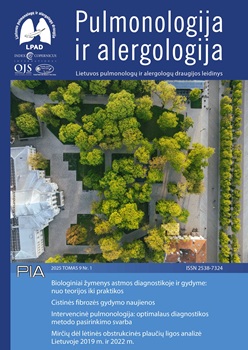COMPARATIVE STUDY OF EFFICACY AND SAFETY OF EXTRA-FINE PARTICLES OF BECLOMETASONE DIPROPIONATE, FORMOTEROL FUMARATE, AND GLYCOPYRRONIUM ADMINISTERED USING DIFFERENT INHALATION DEVICES
Abstract
Three 52-week studies in COPD have assessed the efficacy and safety of single-inhaler extrafine formulation triple therapy combining beclomethasone dipropionate (BDP), formoterol fumarate (FF), and glycopyrronium (G) delivered via pressurized metered-dose inhaler (pMDI). BDP/FF/G is now being developed for delivery via multi-dose dry powder inhaler (DPI; “NEXThaler”). Aim of the study. To demonstrate the non-inferiority of BDP/FF/G DPI vs pMDI for lung function. Methods. Multicenter, randomized, double-blind, double-dummy, active-controlled, three-way crossover study in patients with COPD and post-bronchodilator forced expiratory volume in 1 second (FEV1) 30–80% predicted. Patients received BDP/FF/G 100/6/10 µg via DPI and pMDI, and BDP/FF 100/6 µg via pMDI, all two inhalations twice daily for four weeks, with treatments separated by a two-week washout. The two co-primary objectives were to demonstrate non-inferiority between the two BDP/FF/G formulations for FEV1 area under the curve between 0 and 12 hours post-dose (AUC0-12h) normalized by time and trough FEV1 at 24 hours, both on Day 28. Results. Of 449 patients screened, 366 were randomized, with 342 (93.4%) completing all three treatment periods. The primary objectives were met, with changes from baseline in FEV1 AUC0–12h and trough FEV1 on Day 28 similar for the two BDP/FF/G formulations. BDP/FF/G pMDI and DPI were statistically superior to BDP/FF for these endpoints (p<0.001). A similar proportion of patients experienced adverse events with each treatment (15.5%, 18.7%, and 15.4% with BDP/FF/G DPI and pMDI, and BDP/FF, respectively); the majority were mild or moderate, with few related to treatment. Conclusion. Extrafine BDP/FF/G DPI and pMDI demonstrated similar efficacy and safety in patients with COPD, supporting the DPI formulation as a valid alternative.


